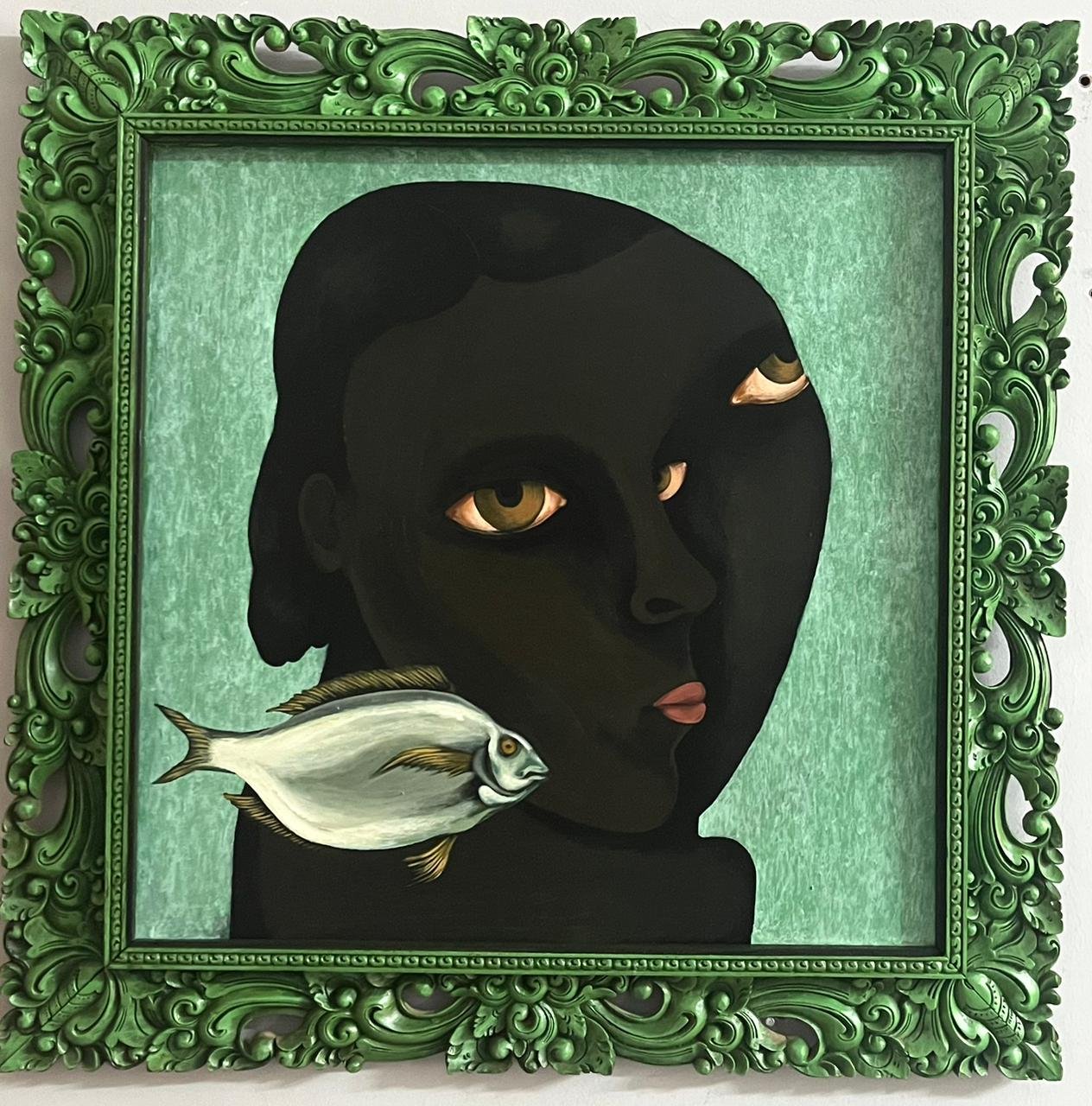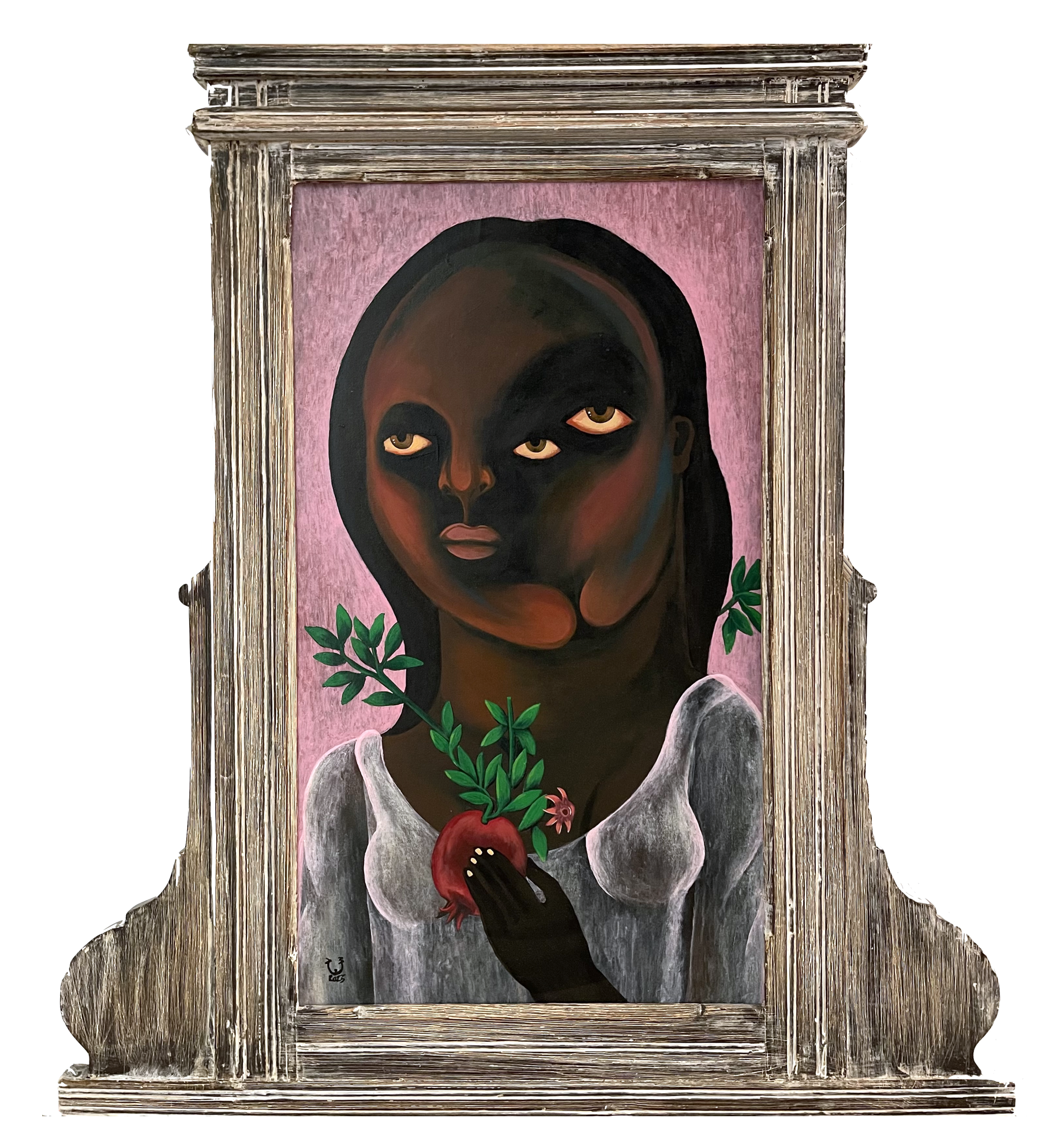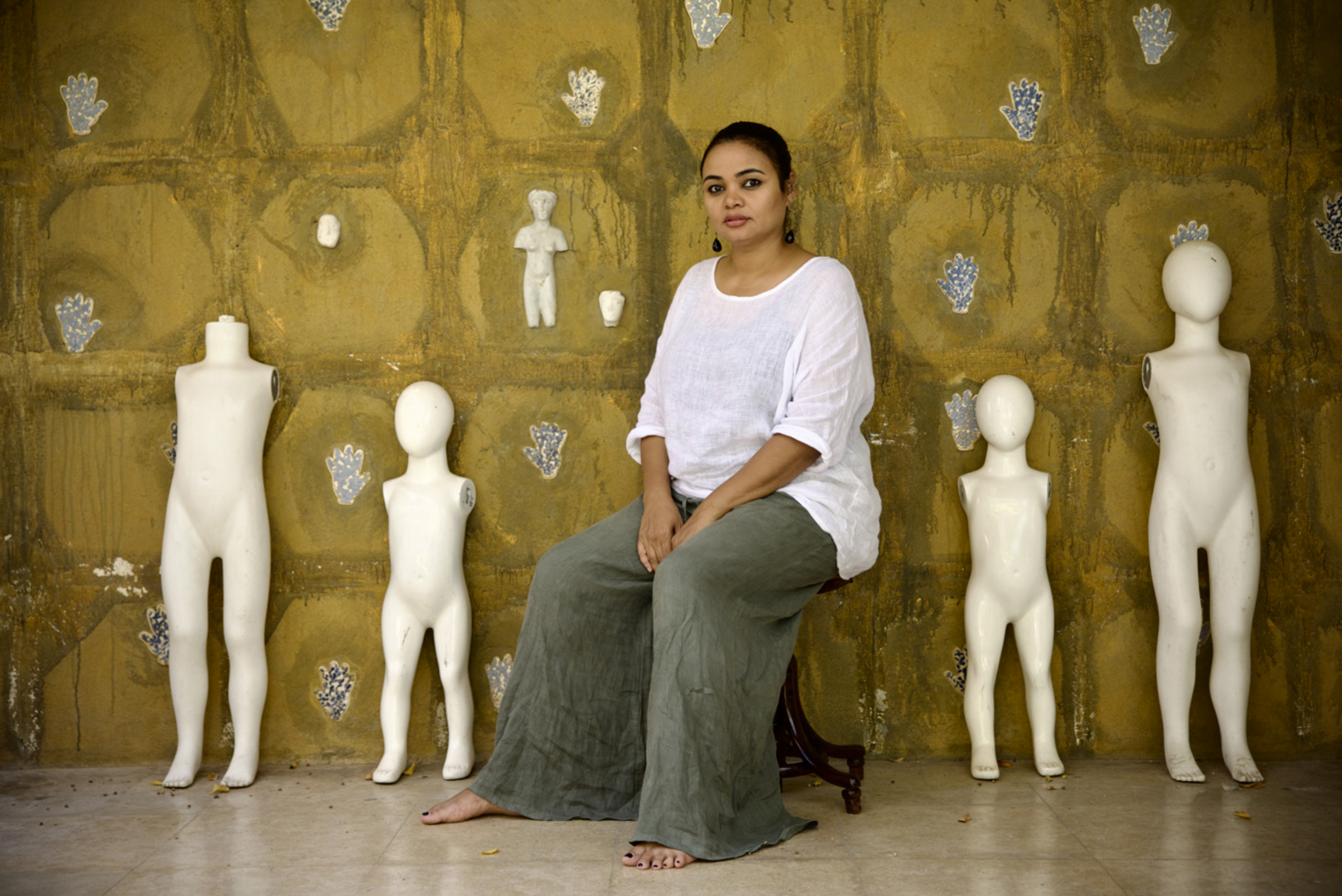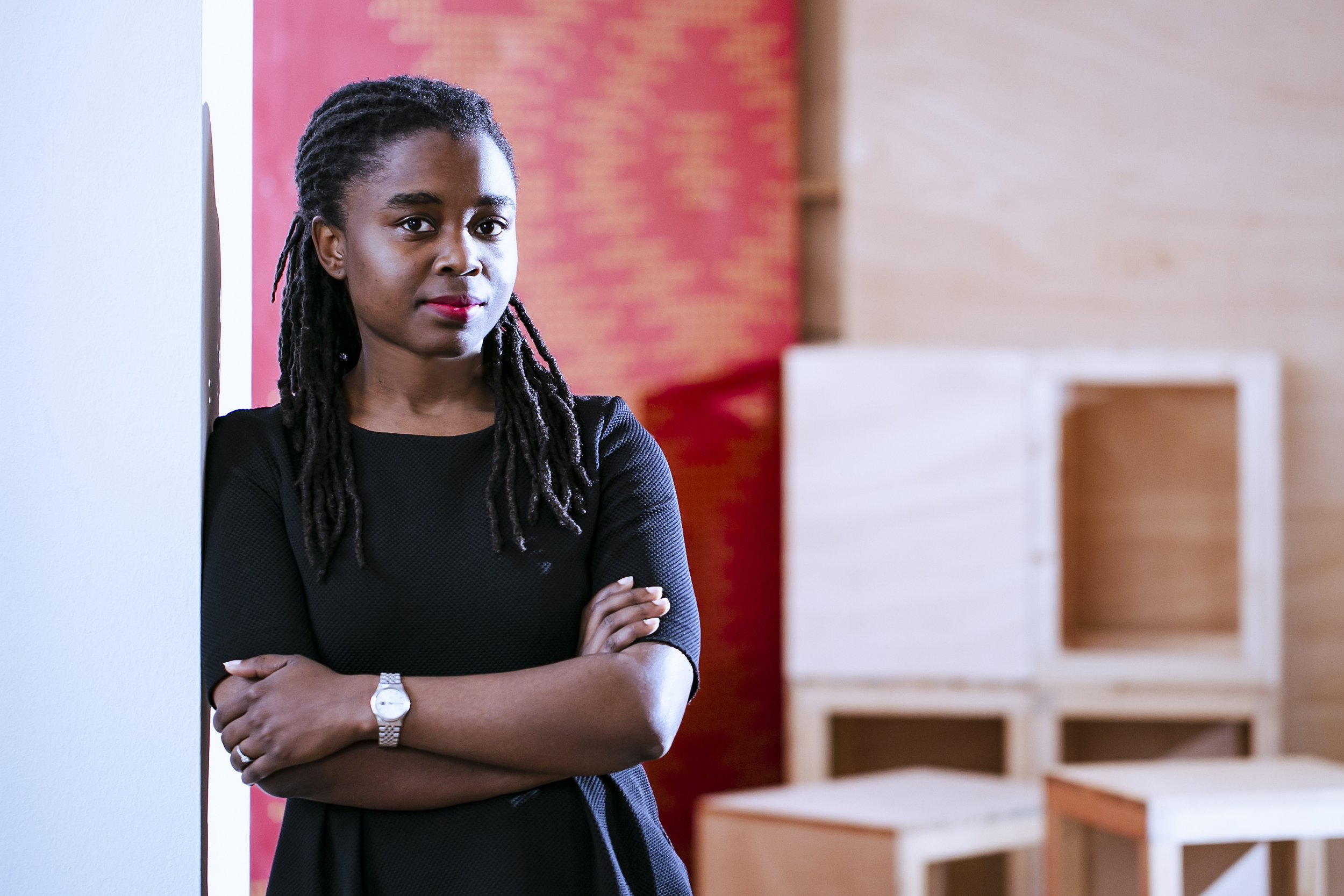
path into the soul
Souad abdelrasoul
02 décembre 2023 - 13 janvier 2024
OH GALLERY, DAKAR
PRÉsentation
par Martha Kazungu
The essence of visual language lies in the viewer's ability to interpret and connect with the artist's message. In the case of Egyptian painter Souad Abdelrasoul, the conventional prerequisites for understanding her work take a back seat. Her genius creations, characterized by a captivating color palette and poetic expressions, draw us in before we grasp the layers of meaning beneath. As we delve into her exploration of semiotics and metaphors, a narrative unfolds—one deeply rooted in Abdelrasoul's personal experiences as a woman in Egypt. Through Abdelrasoul’s work, being a woman progresses on various levels; first as a well-educated woman living in Egypt, poised with the emancipatory ability to objectively observe the world around her and finally as a lover of books, research, reading, Franz Kafka and experimentation. Each of these elements intrinsically shapes Abdelrasoul’s creativity, allowing her to develop a unique and distinguishable style for herself.
While her works forefront her experiences as a woman and are inherently in support of gender equality, Abdelrasoul is reluctant to associate her practice with the label “feminist”. She is instead interested in the emancipatory act of composing her surreal subjects with metaphorical symbolism. Given the circumstances of Abdelrasoul’s creations, it becomes easy to understand why she shows aversion to linking her work to the term feminist. Perhaps she is weary of dealing with the strong reactions that the title feminist elicits. Sarah Ahmed in Living a Feminist life hints on the burdens associated with the term. She asserts that “when you speak as a feminist, you are often identified as being too reactive, as overreacting, as if all you are doing is sensationalizing the facts of the matter; as if in giving your account of something you are exaggerating, on purpose or even with malice.”
Indeed, Abdelrasoul is not blind to the persistent forms of injustices projected to women and to the notion of womanhood in her home country. The repressive roles surrounding dress code and social interactions and other gender stereotypes enable Abdelrasoul to witness an imbalance within her society, which always inevitably sends women to a place of despondency, living a life of deception, fear, and restraint. After closely absorbing, monitoring, and observing her own community, she takes images from her experiences and converts them to motifs for her paintings. Hence her work becomes a product of personal feelings and reflections about how she is treated in her community and how by extension, several other women are subdued because of their gender. The light she shades about the plight of women on a national and universal level inevitably curves a space to think about gender inequality. As Fatima Ali writes in Abdelrasoul’s monograph Like A Single Pomegranatle, “Souad does not merely paint, she questions with her power as an artist, to reveal not just the scene of violence itself with its transgressor’s behavior, but the psychological effects of the acts of violence on women.”
Considering her inherent pursuit to address the woman condition in Egypt side by side with the equitable interconnectedness of human life to its environment, Abdelrasoul employs a diverse set of visual languages - distorted surrealist black bodies, multiple faces, and symbolism. While studying Abdelrasoul’s work, scenes of human figures either emanating from or juxtaposed with animal or plant life are evocatively repetitive. In my interview with the artist, she explains that the multiple faces seek to reveal the different feelings that may coexist within one person. Because of the repressive rules, and the pressure for women to fit in a certain box, they are constantly trying hard to be perceived in a particular acceptable way. For some, the line between truth and deception is too blurry and in constant flux. By presenting her subjects with multiple faces, Abdelrasoul legitimizes the mental fluidity of women with the possibility to change moods, emotions, and feelings. While alluding to several nuances from Egyptian culture, Abdelrasoul also embarks on symbolic metaphors to hone her messages in her paintings, for instance, through portrayal of animals such as fish, rabbits, birds etc. “I refer to women’s fears by painting a rabbit, because the rabbit, in my culture, is a very weak and fearful animal “she explains.
In her first solo exhibition in Senegal and West Africa titled Path to the soul, Abdelrasoul further sensitizes her new audiences to nuances from her inner self, her soul. Hosted by OH Gallery and curated by Océane Harati, the exhibition seeks to introduce Abdelrasoul’s work in West Africa. All paintings within the exhibition are small in scale, allowing the viewer for a close and intimate look to perceive their content. Beyond the size, the artist also upcycles old, discarded wood previously used on everyday objects that furnish homes as intricate frames, a practice which she initiated in 2016. Abdelrasoul’s reversed approach to framing conveys a new meaning. The ritual of framing two-dimensional work usually happens after the work is completed, to enclose and protect, yet in Abdelrasoul’ work, this ritual is reversed. Instead, the frames work as the basis for the form of the painting. The frame therefore becomes the starting point of the work, from where the subjects in Abdelrasoul’s paintings diverge. Consequently, our eyes, while visualizing the work, are directed to observe the work from its perimeter into its inner parts. Directing our gaze to the interior of her compositions not only aptly emphasizes Abdelrasoul’s consistency in the narrative that her works originate from her inner self but also demonstrates Franz Kafka’s influence on her work. In Letters to Milena, Kafka remarks “I am constantly trying to communicate something incommunicable, to explain something inexplicable, to tell about something I only feel in my bones and which can only be experienced in those bones”. Either flowing from the soul or from the bones, both interiors beautifully resonate with the essence of Abdelrasoul’s overall practice. In my conversation with the artist, she remarked on the role of various resources such as maps, vintage books, ancient culture but she is struck by how Franz Kafka’s writing impacts her work both before and after a painting is done.
In a nutshell, albeit disregarding herself as a feminist, Abdelrasoul capitalizes on her experiences as a woman in her society, often exposing the stigma and harassment she faces for failing to submit to the repressive rules governing womanhood. Her work, a visual feeling, has over the years found a distinguishable yet captivating style, offering surrealist female human figures in sync or in combination with their surroundings - alluding to her innate desire to depict man’s equitable relationship with the environment.
Martha Kazungu,
novembre 2023
les oeuvres
ÉVÈNEMENTS
CONVERSATIONS
- R E N C O N T R E -
Rencontre avec l’artiste le mardi 05 décembre à 15h30.
Captation vidéo de la rencontre disponible ultérieurement.
oH LIBRARY
- L A B I B L I O T H È Q U E -
La rencontre avec La Bibliothèque, autour de l’exposition de Souad Abdelrasoul, aura lieu
le samedi 06 janvier 2024 de 15h à 18h.

MÉDIAS > vidéos
MÉDIAS > VIDÉOS
Virtual tour de l’exposition Path into the soul consacrée à Souad Abdelrasoul.
© Almas Art Foundation, 2023
À PROPOS
© Paul Schimweg
Martha Kazungu est une conservatrice et historienne de l'art ougandaise. Elle est titulaire d'un master en arts visuels et verbaux africains, avec une spécialisation dans la conservation et les médias en Afrique, obtenu à l'université de Bayreuth, en Allemagne.
Plusieurs années passées à promouvoir le travail des femmes artistes l'ont amenée à fonder la Njabala Foundation afin de rendre la visibilité aux femmes artistes. Elle fait partie du conseil scientifique de l'exposition Empowerment du Kunstmuseum Wolfsburg. Kazungu est également conservatrice externe pour la Fondation culturelle fédérale allemande Turn2 Labs of 2022. Elle a récemment terminé son mandat de conservatrice adjointe au Museum am Rothenbaum (MARKK) en organisant une exposition dans le cadre de la 8e Triennale de la photographie à Hambourg. Les écrits de Kazungu ont été publiés dans plusieurs revues en Afrique, en Europe et aux États-Unis.
Plus récemment, elle a contribué à l'ouvrage de Phaidon intitulé Great Women Painters and African Artists : From 1882 to Now. Kazungu a organisé des expositions en Europe et en Afrique, notamment Njabala This Is Not How (Ouganda), My Mother is Forgetting My Face (Norvège), Life Classes : une exposition d'art ougandais sur papier (Allemagne), Embodiment of Reason (Ouganda) et Here and Here (Éthiopie). Kazungu est un Kazungu est une ancienne élève de Museum Labs, Independent Curators International (ICI) (Afrique du Sud), Àsìkò School (Éthiopie et Ghana), C& writers' workshop (Kenya) et AtWork (Ouganda). Elle a été conservatrice adjointe pour la Biennale d'art de Kampala 2016 organisée par Elise Atangana en 2016 et pour le Feedback Art Africa and the 1980s organisé par Smooth Ugochukwu à l'Iwalewahaus en 2018.
MARTHA KAZUNGU
© Pedro
Née en 1974, Souad Abdelrasoul vit et travaille actuellement au Caire.
Diplômée en 1998 de la Faculté des Beaux-Arts, en 2005 elle obtient un master en Histoire de l'Art, et en 2012 un doctorat en Histoire de l'Art Moderne. en 2012.
Sa pratique artistique s'étend sur les médiums du dessin, de la peinture, de la sculpture et du design qui fusionne l'art abstrait et figuratif.
En représentant des figures métamorphosées, l'artiste ne cherche pas à visualiser la beauté physique mais tente de réfléchir aux liens entre les humains et les éléments qui l’entourent tels que la terre, les métaux et les végétaux. “Nous faisons partie de la terre et la terre fait définitivement partie de chacun de nous. Des figures ressemblant à des arbres, des veines et des artères ramifiées et des personnages monstrueux ressemblant à des insectes se mêlent sur les toiles et les bustes pour rappeler aux spectateurs le lien vital qui existe entre l'intérieur de l'être humain et son corps.”
Le lien vital entre le corps humain et le monde extérieur est omniprésent. En faisant cela, Souad reconceptualise la façon dont nous percevons l'espace et ré-affecte les notions de corps, de science et de nature en quelque chose de très personnel, intime, qui exalte le sens de la vie, le féminin, l'émotionnel, le naturel envahissant et l'animalesque. Souad Abdelrasoul conçoit également des couvertures de livres et des livres pour enfants. enfants et anime des ateliers d'art pour les enfants en Égypte et ailleurs..
Souad Abdelrasoul
POUR ALLER PLUS LOIN
PRÉSENTATION
EXPOSITIONS
ACTUALITÉS
PODCAST































